
by Alessia Leibert
December 2014
STEM degrees in Minnesota offer plenty of career opportunities, including jobs outside of core STEM industries.
STEM industries and occupations are good for the overall economy because they drive innovation and competitiveness. But what specifically does the STEM economy encompass? That sector of the economy traditionally has been defined as a set of technology-based industries that hire a high percentage of workers with advanced training in science, technology, engineering and math, or STEM.
This definition, based on the occupations and industries shown in Figure 1, is useful as a starting point, but it fails to capture the increasing demand for these credentials beyond STEM industries. Moreover, it overlooks opportunities for people who have less than a bachelor's degree but substantial STEM skills.
To get a better sense of the reach of the STEM workforce in Minnesota, this article looks at all people who recently earned STEM degrees and finds that many have jobs in industries outside the field.
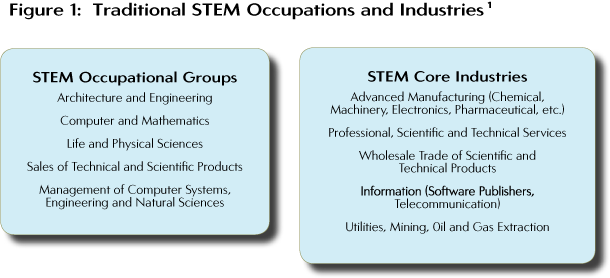
From July 2006 to June 2011, a total of 55,355 people completed a post-secondary degree in Minnesota in a STEM discipline.2 The most popular STEM majors were biological and biomedical sciences, IT, engineering and engineering technologies, each with graduating classes of more than 2,000 a year.
What sectors of the economy absorbed these graduates during the first three years after graduation? As shown in Figure 2, only one out of three (31 percent) was employed in a STEM core industry. The reason is simple: Employment growth in high-tech STEM core industries in Minnesota has slowed and is projected to fall behind other industries.3 Eleven percent found jobs in STEM-related health care industries,4 where STEM skills are becoming increasingly relevant. The remaining 55 percent ended up outside STEM industries.
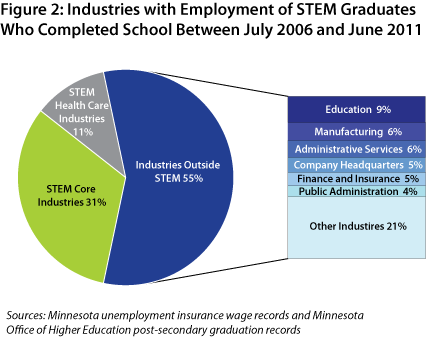
What makes STEM both fascinating and hard to measure is that a STEM education equips students with foundational skills that help them move confidently into a number of careers and industries. Besides health care, the most common non-STEM industries of employment for STEM graduates are education (9 percent of employed STEM graduates), manufacturing (6 percent), administrative services (6 percent), company headquarters (5 percent), finance and insurance (5 percent) and public administration (4 percent).
Although we do not know the occupations of graduates who work in these industries, we can make educated guesses based on educational background, industry of employment, wages and hours worked. For example, graduates might be teaching STEM-related subjects in a school, conducting actuarial or financial analysis for an insurance company, monitoring environmental policy standards in a manufacturing firm or state agency, or running an IT data center at a company's headquarters.
What about graduates who landed a job in a STEM core industry? As shown in Figure 3, the largest group (42 percent) was hired in professional and technical services, followed by 19 percent in computer and electronic product manufacturing, a high-tech industry sector projected to shrink by 11 percent in this decade. Sluggish employment growth in these industries is partially attributable to technological innovations that replace labor with machines and software.
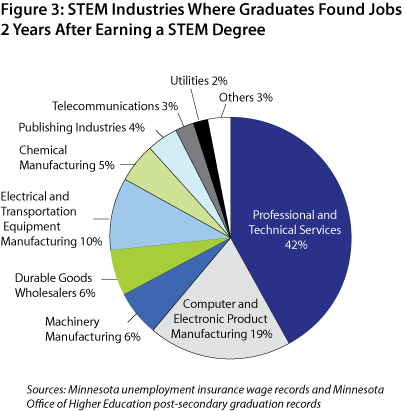
What is the value of a STEM degree if only a minority of STEM-trained workers found jobs in STEM industries? Figure 4 presents evidence of the strong market value of a STEM degree in Minnesota regardless of industry of employment.
Only one year after graduation, people with a bachelor's degree in a STEM field had wages that were nearly $10,000 higher (or 25 percent more) than their non-STEM counterparts and rose more rapidly in subsequent years, indicating high earning potential. People with associate degrees in STEM fields also fared better than others.
STEM graduates were also more likely to be employed full-time for the whole year, as shown by the vertical bars. Fifty percent of graduates in a STEM field were employed full time without interruption during the second year after graduation, compared with 38 percent of people with associate degrees and 43 percent of those with bachelor's degrees in non-STEM fields. Since full-time employment is an indicator of health care and other benefits coverage and because continuous work histories translate to higher wages and better career prospects over time, STEM graduates appear to have better chances of landing a high-quality job than non-STEM graduates.
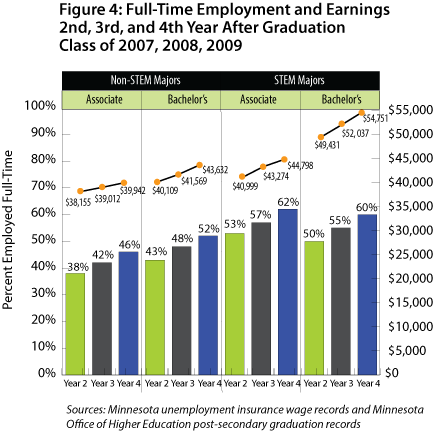
Sixty-seven percent of STEM degree holders from 2006 to 2012 were male. This imbalance masks large differences in gender composition by detailed major, as displayed in Figure 5. Male-dominated majors like IT and engineering pay significantly more than female-dominated majors like biology and agricultural sciences, especially animal sciences. In general, within STEM majors, the lower the earnings after graduation, the greater the share of female graduates.
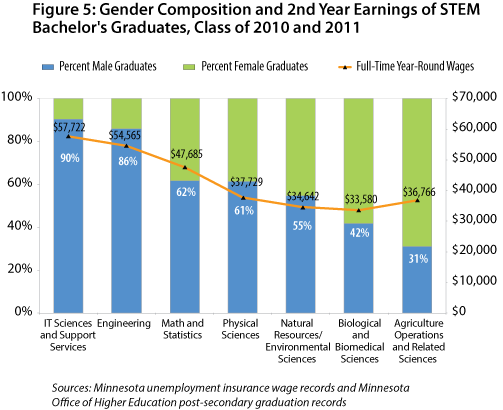
Are women being paid less than men with equal education? The answer is no. There were no differences between full-time wages earned by female and male graduates within the same major and education level. The difference in earnings is driven by the choice of major, which reflects differences in career choices between men and women. We can infer from the figures presented in Figure 5 that women tend to be more interested in careers in health care, veterinary services, food science, public administration and education.
The existence of different typical pathways for male and female STEM graduates in the labor market is confirmed by data on industries of employment. While 40 percent of female STEM graduates worked in health care, education or public administration one year after finishing school, only 19 percent of male graduates worked in these industries. Thirty-four percent of male STEM graduates worked in technology-intensive, private sector industries like professional and technical services and manufacturing, which tend to pay higher salaries.
What we gather from this evidence is that choice of major trumps gender in determining earning prospects in STEM disciplines. Many reasons besides earnings factor into the choice of a career. Job stability prospects, health care benefits and work schedules, for example, might carry more weight for women compared with men. We do not know to what extent choice of major may have been different if women had more role models encouraging them to pursue technology-oriented, male-dominated STEM careers. What we know is that women who graduated in male-dominated STEM fields earned the same wages by industry as their male counterparts, demonstrating women's ability and potential to succeed in any STEM field.
If opportunities in science have been overrated in Minnesota, those in blue collar STEM jobs have definitely been underrated. Short-term engineering certificates like industrial production and quality control technicians are among the top-paying STEM degrees (see Figure 6). IT majors like computer programming and management information systems also offer great opportunities at the undergraduate level.
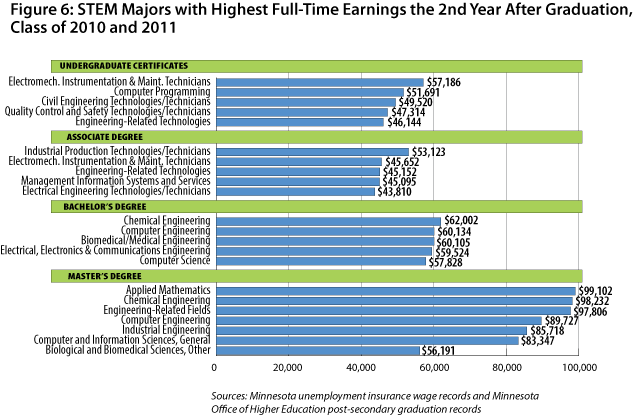
Just one year after graduation, sub-baccalaureate completers in engineering, engineering technologies and IT can already earn far above the $37,765 median wage for all workers in the state. Biology and the physical sciences, in contrast, pay off predominantly at the graduate level, while agriculture and natural resources and conservation do not make the top ranks.
This article offers insight into the composition and economic success of the STEM educational pipeline in Minnesota. Only half of employed STEM degree holders were hired in a STEM core industry, probably as a consequence of slow growth in the state's high-tech sectors and fast growth in health care and other industries where STEM credentials are in demand. In particular, the success of graduates in engineering and IT at all levels of education stands as evidence of high demand for quantitative and analytical skills across industries and occupations.
This article also describes distinct paths into the labor market for female and male STEM graduates, with high concentrations of women in science and health care-related STEM majors and high concentrations of men in IT and engineering. Policies aimed at increasing the STEM education pipeline should also aim to improve gender diversity rather than just increase the size of graduating classes. This would entail encouraging more women to pursue male-dominated, technology-oriented STEM careers.
1This article excludes health care industries and occupations.
2Social science majors, such as sociology, were excluded from the definition of STEM because, with the exception of econometrics, which we included in this study, they generally do not rely on math or the scientific method in their work, and graduates don't typically aspire to work in STEM careers or industries.
3According to 2012-2022 employment projections, STEM industries are poised to grow only by 3 percent versus 7 percent economy-wide.
4Health care STEM industries include offices of physicians and dentists, outpatient care centers, medical and diagnostic laboratories, home health care services, hospitals and nursing care facilities.